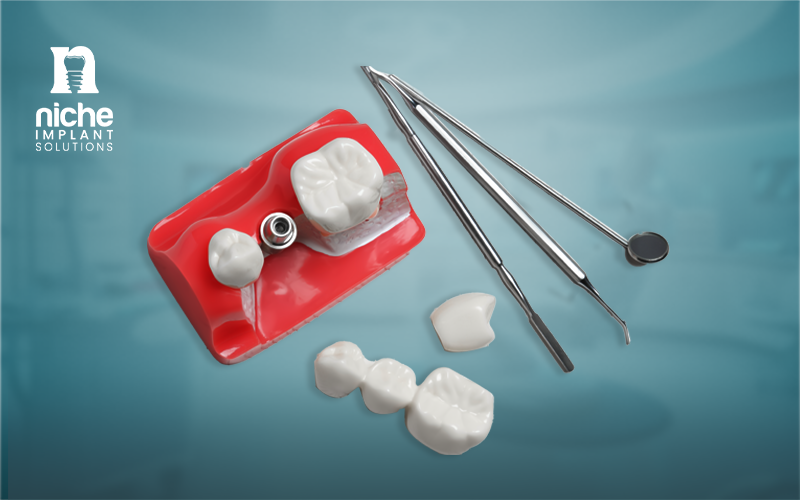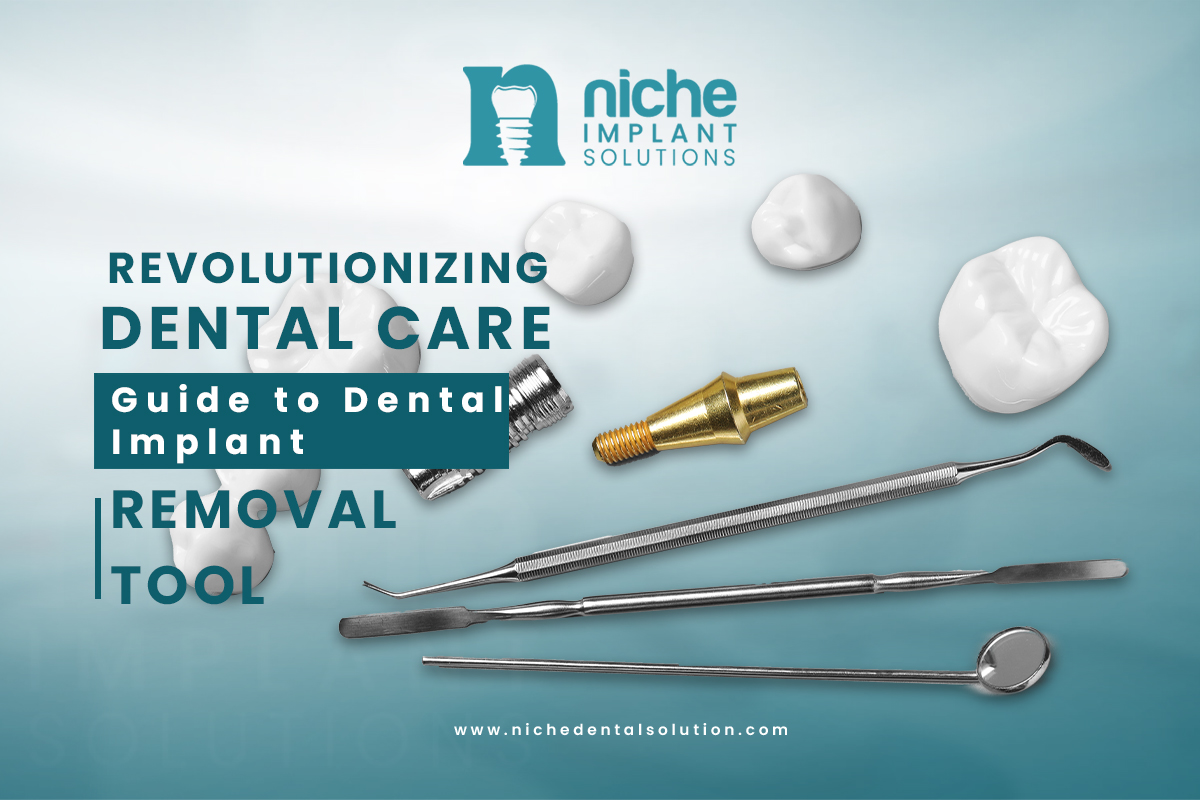A dental implant removal tool is a specialized instrument used by dental professionals to safely and efficiently remove dental implants from a patient’s mouth. Dental implants are typically made from biocompatible materials like titanium and are surgically placed into the jawbone to serve as artificial tooth roots, supporting prosthetic teeth. Although implants are designed to be a long-term solution, certain situations necessitate their removal.
Unlocking the Need: Why Dental Implant Removal Tool Are Essential for Oral Health
The need for implant removal arises in various scenarios, including:
Implant Failure
- Implants may fail due to poor osseointegration, where the bone fails to bond with the implant surface, leading to instability.
Infection
- Peri-implantitis, a condition characterized by inflammation and infection of the tissues surrounding the implant, may require the implant to be removed to prevent further damage.
Implant Malposition
- Incorrect placement of an implant may necessitate its removal and re-positioning for optimal functionality and aesthetics.
Mechanical Issues
- Components of the implant, such as screws or abutments, may become loose or damaged, requiring removal and replacement.
Patient Discomfort
- Persistent pain or discomfort not resolved by other means may lead to the decision to remove the implant.
The dental implant removal tool is designed to facilitate these removals in a manner that minimizes damage to surrounding tissues and preserves as much of the original bone structure as possible.
From Manual Tools to Modern Methods: The Early Days of Dental Implant Removal Tool
The concept of dental implants dates back to ancient times, with rudimentary attempts using shells or carved stones. However, modern dental implants, as we understand them today, began to take shape in the mid-20th century. The development of titanium implants by Dr. Per-Ingvar Brånemark in the 1960s marked a significant advancement in dental technology. These early implants were designed to integrate with the bone through a process known as osseointegration.
Early Removal Techniques
Manual Extraction
Early implant removal often involved basic manual tools such as pliers and chisels. These methods were rudimentary and could be traumatic, leading to significant bone loss and soft tissue damage.
Surgical Removal
In cases where implants were deeply integrated, surgical removal was required. This involved cutting through bone and tissue to access and remove the implant, which was a complex and invasive procedure.
Evolution of Dental Implant Removal Tool
As dental implant technology advanced, so did the tools and techniques for their removal. Key developments include:

Manual Removal Tools
- Implant Removal Forceps: Early specialized tools included forceps designed to grip and remove the implant without causing excessive trauma.
- Osteotomes: These manual instruments allowed for more precise removal by chiseling around the implant to facilitate its extraction with minimal damage to the surrounding bone.
Powered Removal Tools:
- Implant Removal Kits: These kits include a variety of specialized dental implant removal tool and devices designed for different types of implants and clinical situations. Powered drills and torque drivers became common, allowing for controlled and efficient removal.
- Piezoelectric Devices: These advanced tools use ultrasonic vibrations to precisely cut bone and facilitate implant removal with minimal heat generation and tissue damage.
Minimally Invasive Techniques:
- Laser-Assisted Removal: Lasers have been increasingly used to aid in the removal of implants by precisely cutting through soft tissue and bone, reducing the risk of complications and promoting faster healing.
- Atraumatic Removal Techniques: Modern approaches emphasize preserving bone and soft tissue integrity. Tools such as reverse torque drivers and trephine burs allow for implant removal with minimal impact on the surrounding structures.
Modern Advances and Tools
Today, dental implant removal tool have evolved to incorporate state-of-the-art technology aimed at improving outcomes and reducing patient discomfort. Modern tools are designed to be:
- Precision-Oriented: Ensuring minimal disruption to surrounding tissues.
- Efficient: Reducing the time and complexity of the removal process.
- Patient-Friendly: Emphasizing comfort and quick recovery.
These tools play a crucial role in contemporary dental practice, providing clinicians with the means to address complications and ensure the best possible care for their patients.
Beyond the Surface: The Importance of Dental Implant Removal Tool for Complex Cases
Dental implant removal tool play a pivotal role in modern dentistry, providing essential solutions for managing a range of clinical challenges. While dental implants are designed to be a long-term or even permanent solution for tooth replacement, various scenarios may necessitate their removal. Understanding the importance and indications for the use of these specialized tools is crucial for maintaining optimal oral health and ensuring successful patient outcomes.
Scenarios and Clinical Indications for Dental Implant Removal Tool
Dental implants are designed to provide a long-term solution for tooth replacement, often lasting many years without issues. However, there are several clinical scenarios where the removal of dental implants becomes necessary. Understanding these indications is crucial for ensuring patient safety and maintaining oral health.
Common Reasons for Dental Implant Removal Tool
Implant Failure
- Osseointegration Failure: The most common cause of implant failure is poor osseointegration, where the bone fails to integrate with the implant surface. This can result from various factors, including insufficient bone quality or quantity, poor surgical technique, and patient-specific factors such as smoking or systemic diseases like diabetes.
- Immediate vs. Delayed Failure: Implant failures can occur early in the healing process or after many years of function. Immediate failures often relate to surgical complications or infection, while delayed failures are frequently due to biomechanical overload or progressive bone loss.
Infection
- Peri-Implantitis: This is an inflammatory condition affecting the soft and hard tissues surrounding an implant, caused by bacterial infection. Peri-implantitis can lead to progressive bone loss and, if left untreated, may necessitate the removal of the implant to prevent further damage to the surrounding tissues.
- Symptoms and Diagnosis: Symptoms include pain, swelling, and bleeding around the implant site. Diagnosis typically involves clinical examination and radiographic assessment to identify bone loss and inflammation.
You can also read: Mastering the Journey: Navigating the Dental Implant Healing Stages for Lasting Oral Health
Implant Malposition
- Incorrect Placement: Implants may be placed in an incorrect position due to poor planning or surgical error. Malpositioned implants can affect aesthetics, function, and patient comfort, making removal and re-implantation necessary.
- Impact on Prosthetics: An improperly placed implant can compromise the fit and function of the prosthetic restoration, leading to difficulties in biting, chewing, and maintaining oral hygiene.
Mechanical Issues
- Component Failure: Components of the implant system, such as screws, abutments, or the implant body itself, may become loose, break, or wear out over time. These mechanical failures can compromise the stability and function of the implant, requiring removal and replacement.
- Wear and Tear: Over time, the implant and its components are subject to wear and tear, which can lead to complications that necessitate their removal.
In conclusion, dental implant removal tools represent a critical aspect of modern dental practice, addressing diverse clinical scenarios that require the careful extraction of dental implants. These tools are indispensable in managing complications such as implant failure, infection, malpositioning, mechanical issues, and patient discomfort. By enabling precise and controlled removal, they minimize trauma to surrounding tissues and preserve the integrity of the bone structure.

Precision in Practice: Exploring the Role of Osteotomes in Dental Implant Removal
The effective removal of dental implants requires specialized tools that are designed to handle the complexities of various clinical scenarios. These tools range from manual instruments to advanced powered devices, each tailored to specific removal requirements.
Manual Removal Tools
Manual tools are essential for dental implant removal tool in cases where precision and control are paramount. They are often used in conjunction with powered tools to minimize trauma to surrounding tissues.
- Implant Removal Forceps:
Specific Uses: These forceps are designed to grip and remove implants with minimal trauma to surrounding tissues. They are often used in cases where the implant is loose or partially integrated.
Features: They typically have a locking mechanism to securely hold the implant and facilitate its extraction. The design includes a non-slip grip to enhance control during the removal process.
- Osteotomes:
Specific Uses: Osteotomes are manual instruments used to cut or reshape bone around the implant, making it easier to extract. They are particularly useful in cases where bone preservation is critical.
Features: dental implant removal tool have sharp, beveled edges that allow for precise bone manipulation. They come in various sizes and shapes to accommodate different clinical needs.
- Periotomes:
Specific Uses: These instruments are used to sever the periodontal ligament and facilitate the removal of the implant without damaging the surrounding bone.
Features: They have thin, sharp blades that can be inserted between the implant and bone, allowing for a clean and precise separation.
- Trephine Burs:
Specific Uses: Trephine burs are hollow, cylindrical tools used to cut a circular section of bone around the implant. This is particularly useful for implants that are deeply integrated or in cases of significant osseointegration.
Features: These burs are available in various diameters to match different implant sizes. They allow for the removal of both the implant and a small amount of surrounding bone.
Manual dental implant removal tool play a pivotal role in modern dentistry, offering precise and controlled solutions for the extraction of dental implants. These instruments, including implant removal forceps, osteotomes, periotomes, and trephine burs, are essential for addressing a variety of clinical scenarios with different levels of complexity. Their significance lies in their ability to minimize trauma to surrounding tissues, preserve bone structure, and facilitate successful implant removal procedures.
Specialized Niche Dental Solutions: Advancing Implant Dentistry with Customized Removal Tools
A niche dental solution company specializing in dental implant removal tool plays a crucial role in the field of implant dentistry by providing specialized instruments tailored for the safe and efficient extraction of dental implants. These companies focus on developing tools that address specific challenges faced by dental professionals during implant removal procedures, aiming to enhance precision, minimize trauma to surrounding tissues, and improve overall patient outcomes.
By partnering with Niche Dental, you gain access to the best possible tools, exceptional service, and a company committed to the continuous advancement of dentistry in Egypt, all while supporting a company dedicated to social responsibility.
Contact Niche Dental Now, Experience the Difference!!
Call us on : +201011687002





0 Comments